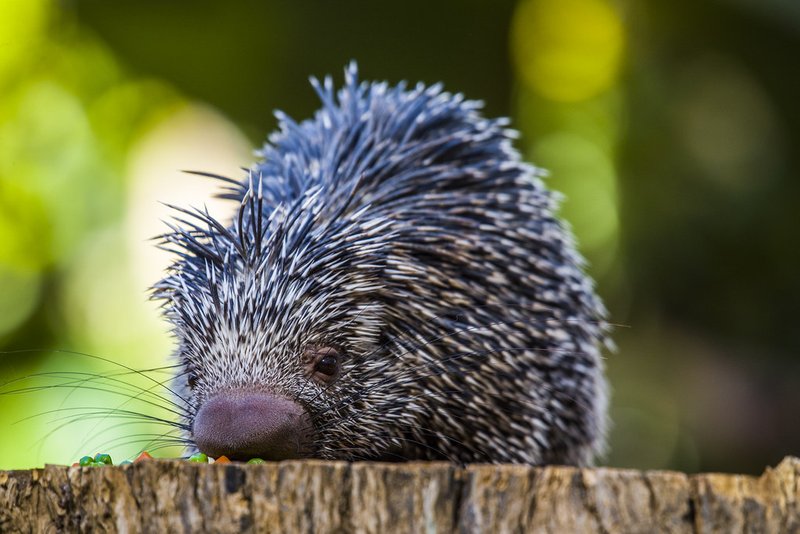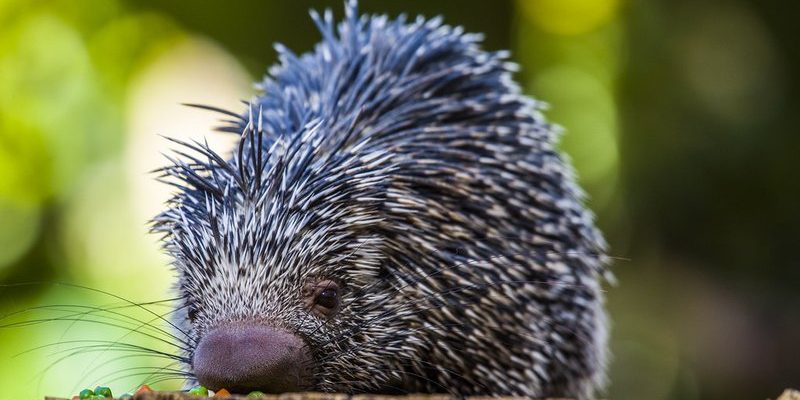
Imagine a creature that can climb trees with the grace of a monkey while sporting a coat of quills that would make even the toughest warrior think twice. This is the Prehensile-Tailed Porcupine. These fascinating animals are not your average porcupine; their unique adaptations allow them to thrive high in the branches of South American forests. If you’re curious about these intriguing creatures, you’re in the right place!
The Prehensile-Tailed Porcupine, or Coendou prehensilis, is a nocturnal rodent that dwells in tropical rainforests. Their name comes from their long, flexible tails, which they use almost like a fifth limb. You might be wondering how they manage to balance on branches and navigate their leafy habitats so effortlessly—it’s all in the tail! Let’s dive deeper into their world.
Physical Characteristics
The Prehensile-Tailed Porcupine has some striking features that set it apart from its relatives. For starters, they are medium-sized rodents, typically weighing between 10 to 20 pounds and measuring around 20 to 30 inches long, with an additional tail that can be about the same length. This tail is not just for show; it’s incredibly agile and prehensile, allowing them to grasp branches securely.
Their bodies are covered in a mix of long, sharp quills and softer fur, which serves as protection from predators. These quills can be quite impressive; they are barbed and can cause discomfort if they come into contact with skin. Think of them as nature’s very own armor! Interestingly, their quills are more than just a deterrent; they play a role in communication. When threatened, they make a hissing sound while erecting their quills to warn intruders.
Color-wise, most Prehensile-Tailed Porcupines have a brownish or grayish hue, helping them blend into their forest surroundings. This camouflage is vital for avoiding detection by hungry predators like jaguars and ocelots. Their large, sharp incisors are excellent for foraging, making them quite adept at slicing through bark to access the leaves and fruits they primarily consume.
Habitat and Range
These porcupines are native to South America, particularly in countries like Brazil, Colombia, and Venezuela. They prefer tropical rainforests but can also be found in drier woodlands. The moisture-rich environment is ideal as it provides ample food and shelter. You could say their choice of home reflects their lifestyle—high up in the trees, where they can climb to safety and feed on a variety of vegetation.
Interestingly, the Prehensile-Tailed Porcupine is quite an adaptable species. While they thrive in dense forests, they can also adjust to fragmented areas caused by human activity. However, this does come with challenges, as their natural habitats are often threatened by deforestation and urbanization. Conservation efforts are essential to ensure these quirky creatures continue to thrive in the wild.
When it comes to their daily routine, these porcupines are mostly nocturnal. They spend the night climbing trees and nibbling on leaves, fruits, and even tree bark. By day, they rest in the hollows of trees, using their quills for protection from predators. This behavior not only keeps them safe but also helps maintain the ecology of their habitat by aiding in seed dispersal as they munch through various plants.
Diet and Feeding Habits
The Prehensile-Tailed Porcupine is primarily herbivorous, which means their diet consists largely of plants. They have a particular fondness for leaves, fruits, and flowers. Their strong teeth and dexterous paws enable them to strip foliage from branches with ease. You might visualize them delicately navigating a tree, carefully selecting the tastiest bits like a gourmet chef picking ingredients!
In addition to leaves and fruits, they also nibble on bark. This behavior helps them get essential nutrients and minerals, especially during times when fruits are less abundant. It’s fascinating how they can thrive on a diet that many might consider unappealing. Their digestive systems are well-equipped to extract nourishment from tough plant materials, allowing them to flourish where other animals might struggle.
Interestingly, the choice of food can vary based on their habitat. In richer areas of the rainforest, they might have a wide variety of fruits to choose from, while in drier regions, they may rely more on leaves. This adaptability is part of what makes the Prehensile-Tailed Porcupine such a resilient species. As they navigate their forest homes, their feeding habits also contribute to the health of the ecosystem by promoting new plant growth and dispersing seeds.
Behavior and Social Structure
Unlike some rodents that prefer a more solitary lifestyle, the Prehensile-Tailed Porcupine is known to be fairly social. They often live in small family groups or pairs, which provides them with safety and companionship. You might picture them huddled together in a tree hollow, sharing warmth and security. This social structure helps them watch out for predators while they forage together.
During the night, you can find them climbing trees, where they exhibit playful behaviors such as chasing one another or play wrestling. These interactions are essential for bonding, and they also help young porcupines learn the skills necessary for survival. Observations suggest that these porcupines communicate through a variety of sounds, body postures, and the positioning of their quills, enhancing their social connections.
When it comes to breeding, the Prehensile-Tailed Porcupine has a relatively low reproductive rate. Females usually give birth to one offspring after a gestation period of about 200 days. This slow breeding rate means that it takes time for their populations to recover from any decline, which is another reason why habitat conservation is so vital. The young are born with soft quills that harden over time, ensuring they have protection as they grow and learn to navigate their world.
Conservation Status
While the Prehensile-Tailed Porcupine may seem robust, their populations face threats primarily from habitat loss due to deforestation and agricultural development. As trees are cut down, their homes disappear, putting pressure on their populations. Although these porcupines are currently listed as “Least Concern” on the IUCN Red List, that doesn’t mean they are out of the woods. Local conservation efforts are essential to protect their habitats and ensure they continue to thrive.
There are organizations working tirelessly to conserve their natural habitats by promoting sustainable forestry practices and protecting areas where these animals live. Additionally, educational programs raise awareness about their role in the ecosystem and the importance of biodiversity. You might even find volunteer opportunities to help support conservation initiatives, which can be a rewarding way to get involved!
By learning more about the Prehensile-Tailed Porcupine and advocating for their protection, we can contribute to the overall health of our planet. These charming creatures are an important part of their ecosystems, and ensuring their survival is not just beneficial for them, but for all of us.
Interesting Facts
| Scientific Name: | Coendou prehensilis |
| Habitat: | Tropical rainforests, woodlands |
| Diet: | Herbivorous (leaves, fruits, bark) |
| Lifespan: | Up to 15 years in the wild |
| Size: | 20-30 inches (including tail) |
| Weight: | 10-20 pounds |
| Behavior: | Nocturnal, social, climbing |
FAQ
What makes the Prehensile-Tailed Porcupine unique compared to other porcupines?
The most distinctive feature of the Prehensile-Tailed Porcupine is its long, flexible tail, which they use for climbing and grasping branches. Unlike other porcupine species, which tend to be ground-dwelling, this species has adapted to an arboreal lifestyle, enabling them to thrive in trees. Their social behavior and communication methods, along with their specialized diet, further differentiate them.
Are Prehensile-Tailed Porcupines dangerous to humans?
Generally, Prehensile-Tailed Porcupines are not dangerous to humans. They are shy and prefer to avoid confrontation. Their quills are a form of defense, but they would rather flee than fight. If threatened, they might hiss and display their quills, but attacks on humans are extremely rare. It’s best to admire these creatures from a distance to avoid startling them.
Can Prehensile-Tailed Porcupines be kept as pets?
While it may be tempting to keep a Prehensile-Tailed Porcupine as a pet, it is crucial to understand their specific needs and behaviors. They require a large habitat, a specialized diet, and social interaction with their kind. Additionally, in many places, it’s illegal to keep wild animals as pets. It’s best to appreciate them in their natural environment or reputable zoos and sanctuaries.
How do Prehensile-Tailed Porcupines reproduce?
Reproduction in Prehensile-Tailed Porcupines usually occurs once a year. After a gestation period of approximately 200 days, a female typically gives birth to one offspring. The young are born with soft quills and quickly grow stronger, allowing them to climb and forage alongside their mother. The slow reproductive rate means that their populations take time to recover from any declines.
What is the role of Prehensile-Tailed Porcupines in their ecosystem?
Prehensile-Tailed Porcupines play a vital role in their ecosystem by aiding in seed dispersal. As they consume fruits and leaves, they help spread seeds throughout the forest, contributing to plant diversity and growth. Their foraging habits can also promote the health of trees, allowing other species to thrive, which underscores their importance in maintaining ecological balance.
What adaptations help Prehensile-Tailed Porcupines survive in the wild?
Prehensile-Tailed Porcupines have several adaptations that enhance their survival. Their prehensile tails allow them to navigate trees with agility, while their quills provide protection from predators. Their strong teeth enable them to eat tough plant materials, and their nocturnal behavior helps them avoid daytime predators. Together, these adaptations make them well-suited for life in the rainforest.
Are Prehensile-Tailed Porcupines social animals?
Yes, Prehensile-Tailed Porcupines are relatively social creatures. They often live in small family groups or pairs, which helps them stay safe from predators. Their interactions include playful behaviors and vocalizations, which strengthens bonds among group members. Social structures in their groups are important for learning survival skills and offering protection.
How can I help protect Prehensile-Tailed Porcupines?
You can contribute to the conservation of Prehensile-Tailed Porcupines by supporting local and international wildlife organizations that focus on rainforest preservation. Educating yourself and others about the importance of biodiversity and sustainable practices can also make a difference. Participating in conservation programs, volunteering, or donating can help protect these unique creatures and their habitats.
What threats do Prehensile-Tailed Porcupines face?
The main threats to Prehensile-Tailed Porcupines include habitat loss due to deforestation, agriculture, and urban development. These activities not only reduce their living space but also diminish food supplies. Additionally, climate change can impact their habitat and food availability. Therefore, conservation efforts are critical to ensuring their survival.
Do Prehensile-Tailed Porcupines have natural predators?
Yes, Prehensile-Tailed Porcupines have a few natural predators. Jaguars, ocelots, and hawks are known to prey on them. Their nocturnal lifestyle helps them avoid some predators, but those that hunt at night can present a significant threat. Their quills offer some protection, but their best defense is often simply to remain hidden in the trees.
What sounds do Prehensile-Tailed Porcupines make?
These porcupines are known to communicate through a variety of sounds, including hisses and growls, particularly when they feel threatened. These vocalizations, combined with the positioning of their quills and body language, help them express their feelings and establish social bonds. Understanding their communication can provide insight into their behaviors and social structure.

